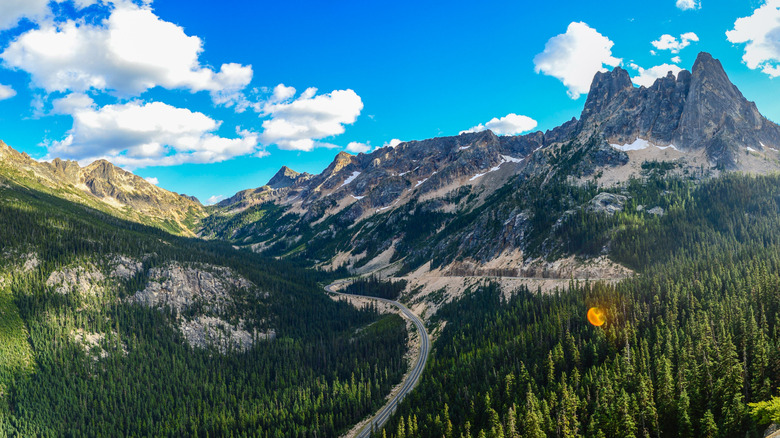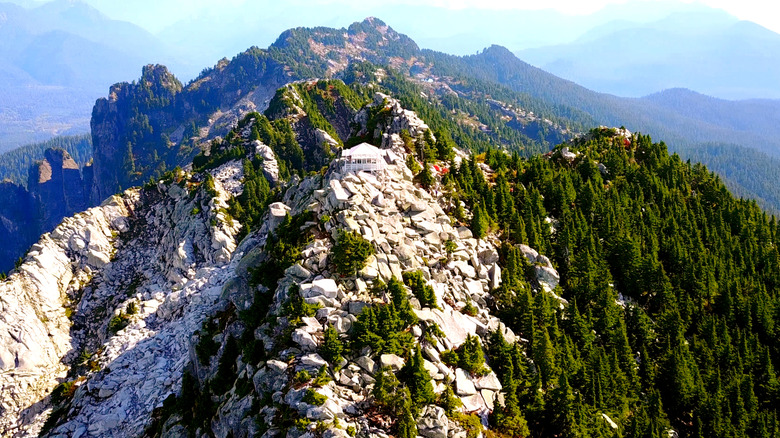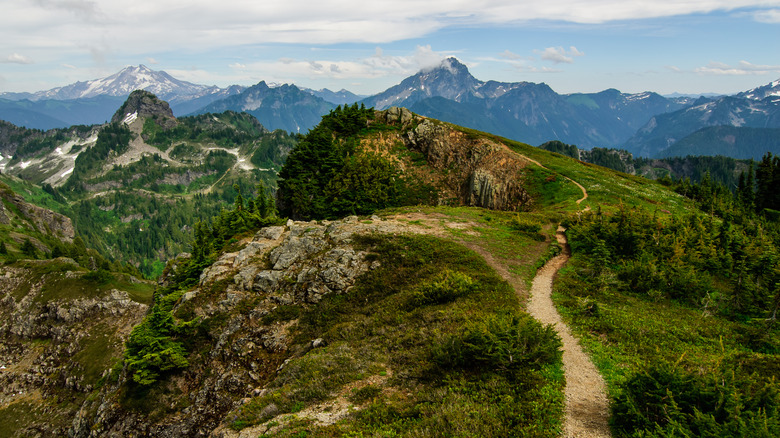One Of Washington's Most Underrated Drives Takes You From Stunning Ice Caves To A Forgotten Mining Town
The great thing about going on a road trip or taking a scenic drive is that it represents the oldest (and perhaps best) adage of travel: It's the journey, not the destination, that really matters. The point is to decidedly not have a point, to avoid treating adventure like a task to be fulfilled or a meeting to be attended. Thankfully, the United States is home to several world-class byway drives — from Maryland's "All-American" Scenic Byway to cruises showcasing Wisconsin's underrated Great Lakes beauty and West Coast routes that take you through California's winding roads and breathtaking canyons.
Add Washington's Mountain Loop Scenic Byway to that list. We're talking 55 miles of road that takes you about as far out into Pacific Northwest nature as you can get without hopping on an all-terrain vehicle. Roughly an hour-and-a-half journey one way, the loop is actually a U-shaped drive serving up views of the Cascades that are so majestic they'll make you scramble to take dozens of photos before realizing that kind of beauty simply can't be captured with a lens. Lush forests are a given in this part of the country, but you'll also see glacial rivers, towering peaks, and abandoned 1890s mining towns.
One end of the loop starts at Granite Falls (the other end being located at Darrington to the north), which is a breezy hour's drive from Seattle. That means the byway makes a fantastic day trip from the bustling city. And if you're looking for more to do than just cruise, you'll be hard pressed to find a better jumping-off point for some truly world-class hiking, camping, wildlife viewing, and photography. Either way, the byway represents a chance to take in Washington's grandeur without having to plan an all-out expedition into the deep Pacific Northwest woods.
The Mountain Loop Scenic Byway's natural wonders and hiking highlights
The Mountain Loop Scenic Byway is a portal to some of Washington's most breathtaking backcountry, and you don't have to be a seasoned mountaineer to enjoy it. Big Four Mountain is one of the first major sights on the byway, and its 4,000-foot-high north face and famous ice caves have long made it a draw for hikers in the region. Park at the Big Four Ice Caves trailhead for a laid-back stroll on a boardwalk to reach the caves (which formed over the years from an avalanche debris cone) all while taking in some spectacular mountain views on the way.
If you're craving a deeper immersion into the landscape, consider heading to the Heather Lake Trail on Mount Pilchuck, right off the byway near the town of Verlot. At 4.3 miles round trip, it's more suited to experienced hikers than the Big Four Ice Caves trail, but the views, streams, and cliff-rimmed alpine lake are more than worth the effort to arrive. Be aware that the trail will be closed from May 1 to July 18, 2025, for scheduled maintenance.
For some, the Mountain Loop Scenic Byway is the thin end of the wedge for access to some seriously rewarding — and challenging — hiking. The bravest of hearts can opt for hiking up the entirety of Mount Dickerman, located just across from the Big Four Ice Caves hiking route along the byway. This is a full-day trek that takes you up to some awe-inspiring views of the Glacier Peak Wilderness, and on a clear day, you'll be able to see at least half a dozen peaks in the distance: Whitehorse, Three Fingers, Baker, White Chuck, Pugh, Sloan, Shuksan, and Glacier Peak are all on display from the top of Mount Dickerman.
Ghost towns and scenic stops on the Mountain Loop Highway
One must-see stop is Monte Cristo, a once-bustling silver ore mining hub in the late 1800s that is now a veritable ghost town. Today, it stands as an eerily beautiful relic of the past, with scattered remnants of old buildings and mining equipment dotting the landscape. Accessing the town requires a 4-mile hike from the Barlow Pass trailhead, moving visitors along a closed road broken up in places by occasional flooding. Connecting history to the present is the fact that Monte Cristo was once home to a hotel owned by Frederick Trump, the grandfather of Donald Trump. The hotel-turned-lodge eventually burned down in 1983 under mysterious circumstances.
Beyond Monte Cristo, the byway offers several other attractions worth exploring. The Verlot Public Service Center serves as an excellent resource for information on local trails and conditions, and it also doubles as a picnic spot before continuing down the byway. The nearby Stillaguamish River means opportunities for fishing, especially during salmon spawning season, and makes for a great spot to take a refreshing dip in the summer. About an hour's drive beyond Monte Cristo is White Chuck Overlook, where you can stop for a lunch break while taking in the panoramic views of nearby mountain valleys. The overlook features restrooms and, if you're lucky, the occasional mountain goat or two.
Pay attention to the seasons when you're planning a drive on the byway, as the roads are usually open from late spring to early fall on account of heavy snowfall during the winter. The route does include sections of unpaved dirt and gravel roads, especially in the stretch beyond Monte Cristo, so make sure your vehicle and driver are comfortable with these kinds of conditions before heading out.


